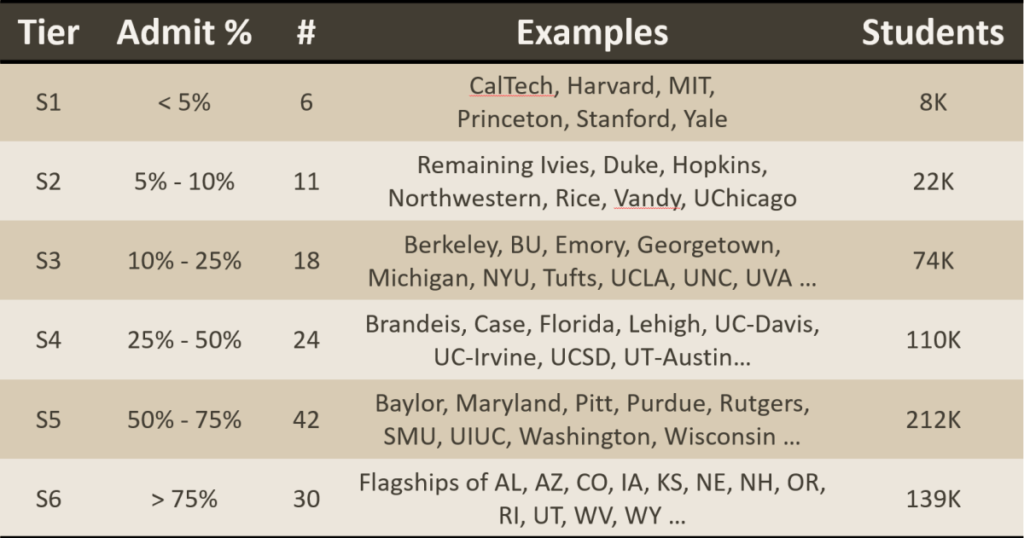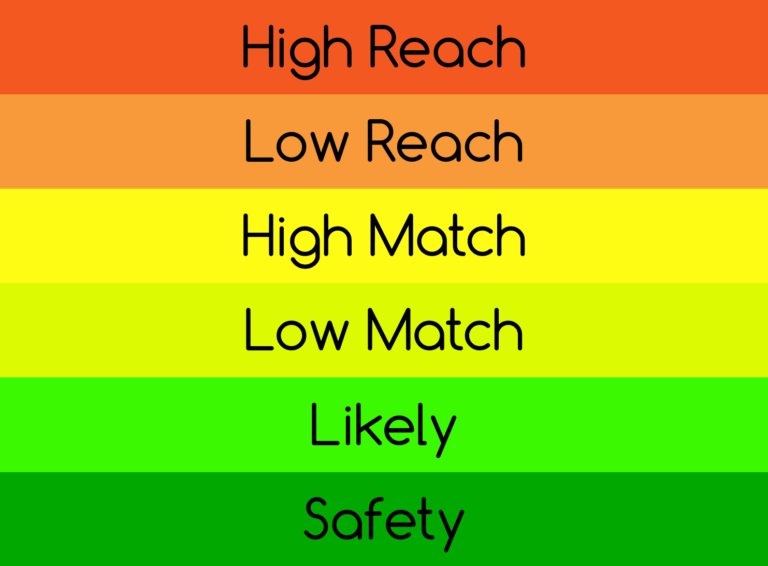
This article classifies colleges into six tiers of selectivity, ranging from extremely selective to nearly open admission. Colleges within a tier tend to have many things in common, including how holistic their admission process is, and the generosity of their financial aid.
Note that in this article I am explicitly talking about college selectivity, not college quality. There is no substantial education quality difference between the US News #1 college (currently Princeton) and their #25 college (currently Michigan). There are many flaws with the US News ranking system, and that might become a topic for a future post.
But we can take the US News rankings and use them to understand tiers of selectivity. So in this post I am starting with the top 100 universities in the 2023 US News and World Report ranking of National Universities. There are 104 universities here due to ties at the end. I then added 27 state flagships that were not included in the US News top 100 list, for 131 total universities.
Two notes before the core of this article begins. First, I am excluding liberal arts colleges in this analysis. While many are excellent, the main point of this article is to identify the difference between tiers, with less importance given here to which college is in a particular tier. Second, even though this particular post will only be analyzing universities, I will use the world “college”, both in this post and sitewide, to represent the undergraduate program at these universities, as well as at liberal arts colleges.
Six Selectivity Tiers
In this post, I identify six tiers of selective colleges. Let’s start with a summary table before we go into the details of each.

In all, this table represents 131 universities that collectively enroll an estimated 567K freshmen each year. If we conservatively assume that 90% of these freshmen are domestic students, that is about 510K domestic students. Nationally, an estimated 1.88M US students joined a 4-year college in 2019, so just these 131 universities absorbed over a quarter of them.
In describing the admission chances for students below, I will be taking the perspective of “unhooked”Applicants that do not benefit from "hooks". Examples of hoo... More students applying from a respected public high school. By respected public high school, (hereafter shortened as RPHS), I mean one where dozens of students regularly apply to highly selective colleges, and therefore the admissions officers know this high school relatively well. These students do have a chance of admission, but realistically it is considerably lower than for hooked students, or from students from elite private feeder schools.
Tier S1
Selectivity tier S1 contains six universities with an admission rate of 5% or less, and they collectively only enroll about 8K students each year. These six universities are all private, among the world’s best known, and have the following characteristics in common:
- Generous Need-Based Financial Aid: These colleges offer some of the most generous financial aid anywhere. Princeton is free to families making less than $85K per year. All except CalTech have a “no-loans” policy meaning students needing financial aid will graduate free of debt. Note that none of these colleges offer merit scholarships.
- Very Few Mistakes Allowed: These colleges expect all students to take a highly rigorous curriculum and expect to see near perfection in transcripts for unhooked students. One B is usually fine, but multiple Bs can kill your application.
- Exceptional Talent Expected: Because the actual admit rate for “unhooked”Applicants that do not benefit from "hooks". Examples of hoo... More students is considerably lower than it appears, the best chance for unhooked students to gain admission is through an exceptional talent (aka “spike”An exceptional talent in an academic or extracurricular area... More) recognized at the national or international level.
- Early Action: Every one of these colleges is confident enough that they only offer Early Action, and do not offer Early Decision. This means that a student can get an offer of admission in December, but not have to commit until the following May after considering all regular decision acceptances. MIT offers unrestricted Early Action, meaning that students can apply early anywhere else. The others offer restricted Early Action, meaning that students cannot apply early to any another private college, but can apply to public colleges.
Many students are tempted to apply early to these colleges because their Early Action policy means admitted students are not required to attend. These applicants notice that most of these colleges have higher admit rates for early action than regular decision, and think applying early will improve their odds. This is largely false because the early applicant pool contains many hooked students (particularly athletes) that drives this admission rate higher.
The reality is that most highly talented students are making a mistake applying early to one of these five colleges that practice restricted early action (i.e. all but MIT). It is pretty common for an “RPHS”Respected Public High School. An academically strong high sc... More to have dozens of students apply to these colleges and get zero students admitted. Unless a student’s application is spectacular, they are better off dropping to tier S2 and applying early decision.
Tier S2
Tier S2 contains 11 universities with admit rates between 5%-10% and collectively enroll about 22K freshmen per year. The eleven universities in this tier are all private and are (in alphabetical order): Brown, Columbia, Cornell, Dartmouth, Duke, Johns Hopkins, Northwestern, Rice, UChicago, UPenn, and Vanderbilt. These colleges have the following things in common:
- Generous Need-Based Financial Aid: All of these colleges are still “need-blind”A college that is need-blind makes admission decisions witho... More and meet full need. The vast majority are also “no-loan”, meaning that students graduate with no debt.
- Very Limited Merit Scholarships: Unlike Tier S1, where no colleges offered merit scholarships, a few colleges in tier S2 do offer them (Duke, Rice, UChicago, and Vanderbilt as of this writing) to entice exceptional students to attend.
- Very Few Mistakes Allowed: In terms of expected academic accomplishments, there is very little difference between students accepted to tier S1 vs those admitted to tier S2. Students are still expected to take a rigorous courseload and achieve near perfection. Back when tests were required, test scores of students in these colleges were virtually identical to that of Harvard, Yale or Princeton.
- Strong Talent Wanted: This is where the difference appears between S1 and S2. Unhooked students admitted at this level typically still have a spike, but it can be less developed than needed for tier S1.
- Early Decision: All of these colleges rely heavily upon early decision, meaning if the student is accepted early, they must attend. As an enticement for applying early, they offer a significantly higher admission rate, even for unhooked students, compared to regular decision.
Realistically, there is zero difference in education quality or available resources between tiers S1 and S2. And while the low admission rates still seem daunting, admission to these universities becomes more realistic for the strong applicants from a “RPHS”Respected Public High School. An academically strong high sc... More, particularly for those applying Early Decision.
Tier S3
The first public universities appear in tier S3, which contains 18 public and private colleges with an admit rate between 10%-25%. Even though this tier has about the same number of universities as S1 and S2 put together, the average class sizes is considerably larger, and therefore tier S3 educates about 2.5x as many students as those in S1 and S2 put together. I list the colleges in this tier, and all successive tiers, at the end of this post.
The things common about colleges in this tier are the following:
- Still Good Financial Aid: Every private college in this tier still uses need-blind admission for domestic applicants. They also promise to meet the full need of every admitted student, but may require taking out student loans. The public universities in this tier are usually inexpensive for in-state students but can be quite expensive for out-of-state students.
- Typical Terrific Students Welcome: This is the fist tier where unhooked students no longer need a strong spike to have a realistic shot at admission. While a spike still helps with admissions, strong well-rounded students (what I call “typical terrific”A "typical terrific" student checks all the right boxes to b... More) also regularly get admitted.
- Slight Relaxing of Grades & Rigor: Students admitted to these colleges can often get away with a slightly less rigorous courseload, or a couple of Bs with the most rigorous courseload.
- Outstanding Educational Quality: The education quality at these colleges is still top-notch, but there might be fewer available resources. For example, some majors might be impacted meaning that it’s difficult to get the courses needed on time. Student-teacher ratios start getting higher.
Tier S4
This consists of 24 colleges with an admit rate between 25% – 50%, the majority of which are public universities like Florida, Georgia, SUNY- Stony Brook, UT-Austin, and UCSD. Private universities in this tier include Brandeis, Case-Western, Lehigh, and Rochester. The common characteristics of colleges in this tier include:
- Public University Bargains: Some of the public universities in this tier offer free tuition or a free ride to stellar in-state students. National merit scholars can attend for free at Florida, Florida State, or the University of South Florida. Georgia offers free tuition to top students. The rest provide a quality education at in-state prices.
- Most Private Colleges Meet Full Need: There are 10 private colleges in this tier, and most of them promise to meet full need. The ones that meet-full need are Brandeis, Case-Western, Lehigh, Miami, Rochester, and Wake-Forest.
- Less Holistic Admissions: Activities become less important, meaning grades become more important at this tier. At UT-Austin grades are paramount, with automatic admission to anyone in the top 6% of their class. Test scores matter more as well (except for the University of California colleges which remain test-blind).
- Roughly Top Fifth of Class Accepted: Colleges at this tier are no longer looking for just the very top of the class. Outside of outstanding flagships like UT-Austin and Florida, most of these colleges are willing to consider students in the top 20% of a high school’s class.
Tier S5
This tier contains 42 colleges with admit rates between 50%-75%, and collectively enroll about 212K freshmen. Public universities are dominate here, making up 27 of the 42 colleges, and enrolling about 175K freshmen. But quality private colleges here include Rensselaer Polytechnic. Characteristics of this group include:
- Private Schools Getting Expensive: Almost no private college in this tier meets full need. A notable exception is Southern Methodist University.
- Quality Still Remains: It’s amazing and wonderful that academic powerhouses like Ohio State, Pittsburgh, Purdue, Wisconsin and the University of Washington have such high admission rates. But note that it can be more difficult for certain majors like engineering or or computer science.
- Admissions Largely Formulaic: GPA rules supreme, and solid test scores help for places that take them.
- Roughly Top Third of Class Accepted: Admission is now getting easy for solid students.
Tier S6
This tier consists of 30 colleges with an admit rate of 75% or higher. Most of them are the state flagships outside the US News top 100. I include them because almost all of them can provide a quality education. One of them was my undergraduate alma mater, the University of Kansas, which launched me on my multiple careers of software engineering, product marketing and quantitative finance. The characteristics of these colleges are:
- Nearly Open Admissions: These schools have very low admission requirements. For example, the University of Kansas guarantees admissions to all students with an unweighted high school GPA of 3.25.
- Affordable Quality Education: Despite the open admissions, a quality education is still available. Almost all also have an honors program, allowing intelligent students to find an equally capable set of peers.
And that’s pretty much it for selectivity among US universities. There are nearly 4000 more that offer 4-year degrees but are open to nearly anyone that applies.
Colleges in Each Tier
For completeness, I list the colleges in each selectivity tier used to generate the summary table at the beginning of this post. All colleges within a tier are listed in alphabetical order.
- Tier S1: CalTech, Harvard, MIT, Princeton, Stanford, Yale
- Tier S2: Brown, Columbia, Cornell, Dartmouth, Duke, Johns Hopkins, Northwestern, Rice, University of Chicago, University of Pennsylvania, and Vanderbilt
- Tier S3: Boston College, Boston University, Carnegie-Mellon, Emory, Georgetown, Georgia-Tech, Michigan, Northeastern, Notre Dame, NYU, Tufts, Tulane, UC-Berkeley, UCLA, UNC-Chapel Hill, USC, UVA, WashU
- Tier S4: Brandeis, Case-Western, Clark University, Clemson, Florida, Florida State, Georgia, Howard University, Lehigh, Loyola Marymount, Miami, Rochester, SUNY-Binghamton, SUNY-Stony Brook, UC-Davis, UC-Irvine, UCSB, UCSD, Univ of South Florida, UT-Austin, Villanova, Wake Forest, William & Mary
- Tier S5: Alaska, American, Auburn, Baylor, BYU, Colorado School of Mines, Connecticut, Fordham, George Washington, Hawaii, Louisiana State, Maryland, Minnesota, NJIT, Ohio State, Penn State, Pepperdine, Pittsburgh, Purdue, RPI, Rutgers, Santa Clara Univ, Southern Methodist Univ, Stevens Institute of Technology, SUNY-Buffalo, Syracuse, Texas A&M, TCU, UC-Riverside, UCSC, UIUC, UMass-Amherst, Vermont, Virginia Tech, Washington, WPI, Yeshiva
- Tier S6: Alabama, Arizona, Arkansas, Colorado, Elon, Idaho, Indiana, Iowa, Kansas, Kentucky, Marquette, Michigan State, Mississippi, Missouri, Montana, Nebraska, Nevada (Reno), New Hampshire, North Dakota, Oklahoma, Oregon, Rhode Island, South Dakota, Tennessee (Knoxville), UC-Merced, Univ of Illinois-Chicago, Utah, Wyoming, West Virginia






